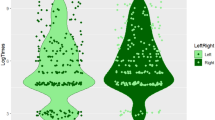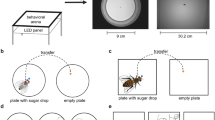Summary
Individual workers of the honeybee (Apis mellifera), trained to collect food from a patch of artificial flowers, were used to test the following hypotheses about the mechanism leading to a decrease in flight directionality when moving from one flower to the next. Directionality decreases with (1) an increasing amount of energy taken from a flower, (2) an increasing amount of time spent on a flower, or (3) an increasing profitability of the flower, i.e. rate of nectar uptake. The bees were tested singly on an arrangement with equidistant flowers. They could move from a decision point forward, right, left, or backwards to the next flower. The rewards at the decision point were altered. When rewards at this point were compared that offered the same quality of “nectar” (50% sugar solution), the time hypothesis (2) was consistent with the observed behaviour of the bees. When conditions were compared that involved two different reward qualities (50% and 25% sugar solation), none of the original hypotheses could entirely account for the results.
It is suggested that a slight modification of the time hypothesis would be consistent with the observations: The bees might possibly “forget” their arrival direction on the flower with increasing time, but forgetting the direction of the last flower visited is intensified with more concentrated rewards.
Similar content being viewed by others
References
Butler CG (1951) The importance of perfume in the discovery of food by the worker honeybee (Apis mellifera L). Proc R Soc (Lond) B 138:403–413
Corbet SA (1978) Bee visits and the nectar of Echium vulgare L. and Sinapis alba L. Ecol Entomol 3:25–37
Corbet SA, Unwin DM, Prŷs-Jones OE (1979) Humidity, nectar and insect visitors to flowers, with special reference to Crataegus, Tilia, and Echium. Ecol Entomol 4:9–22
Frisch K v (1965) Tanzsprache und Orientierung der Bienen. Springer, Berlin Heidelberg New York
Heinrich B (1979) Resource heterogenity and patterns of movement in foraging bumblebees. Oecologia (Berl) 40:235–245
Heinrich B (1983) Do bumblebees. Oecologia (Berl) 40:235–245
Heinrich B (1983) Do bumblebees forage optimally, and does it matter? Am Zool 23:273–281
Heyneman AJ (1983) Optimal sugar concentration of floral nectars—dependance on sugar intake efficiency and foraging costs. Oecologia (Berl) 60:198–213
Hodges CM (1981) Optimal foraging in bumblebees: hunting by expectation. Anim Behav 29:1166–1171
Kramer E (1976) The orientation of walking honeybees in odour fields. Physiol Entomol 1:27–37
Krebs JR, Stephens DW, Sutherland WJ (1983) Perspectives in optimal foraging. In: GA Clark (ed) Centennial volume of the American Ornithologists Union. Cambridge University Press, New York
Levin DA, Kerster HW, Niedzlek M (1971) Pollinator flight directionality and its effect on pollen flow. Evolution 25:113–118
Michener CD (1974) The Social Behavior of the Bees. Belknap Press, Harvard University
Pleasants JM (1981) Bumblebee response to variation in nectar availability. Ecology 62:1648–1661
Pleasants JM, Zimmerman M (1979) Patchiness in the dispersion of nectar resources: evidence for hot and cold spots. Oecologia (Berl) 41:283–288
Price MV, Waser NM (1979) Pollen dispersal and optimal outcrossing in Delphinium nelsone. Nature 277:294–297
Pyke GH (1978a) Optimal foraging: movement patterns of bumblebees between inflorescences. Theor Popul Biol 13:72–98
Pyke GH (1978b) Optimal foraging in bumblebees and coevolution their plants. Oecologia (Berl) 36:281–293
Pyke GH (1978c) Are animals efficient harvesters? Anim Behav 26:241–250
Pyke GH (1981) Foraging bumblebees: rule of departure from an inflorescence. Can J Zool 60:417–428
Roubik DW, Buchmann SL (1984) Nectar selection by Melipona and Apis mellifera (Hymenoptera: Apidae) and the ecology of nectar intake by bee colonies in a tropical forest. Oecologia (Berl) 61:1–10
Sachs L (1978) Angewandte Statistik, 5. Aufl. Springer, Berlin Heidelberg New York
Seeley TD (1984) The information-center strategy of honeybee foraging. Fortschr Zool (in press)
Thomson JS, Plowright RC (1980) Pollen carryover, nectar rewards, and pollinator behavior with special reference to Diervilla lonicera. Oecologia (Berl) 46:68–74
Waage JK (1978) Arrestment response of the parasitoid Nemeritis canescens to a contact chemical produced by its host, Plodia interpunctella. Physiol Entomol 3:135–146
Waddington KD (1980) Flight patterns of foraging bees relative to density of artificial flowers and distribution of nectar. Oecologia (Berl) 44:199–204
Waddington KD, Heinrich B (1981) Patterns of movement and floral choice by foraging bees. In: A Kamil, T Sargent (eds) Foraging behavior. Garland Press, New York
Waller GD (1972) Evaluation of responses of honeybees to sugar solutions using artificial flower feeders. Ann Entomol Soc Am 65:857–862
Woodell SRJ (1978) Directionality in bumblebees in relation to environmental factors. In: Richards AJ (ed) The pollination of flowers by insects. Academic Press, New York
Wright S (1969) Evolution and the genetics of populations. University of Chicago Press, Chicago
Zimmerman M (1979) Optimal foraging: a case for random movement. Oecologia (Berl) 43:261–267
Author information
Authors and Affiliations
Rights and permissions
About this article
Cite this article
Schmid-Hempel, P. The importance of handling time for the flight directionality in bees. Behav Ecol Sociobiol 15, 303–309 (1984). https://doi.org/10.1007/BF00292993
Received:
Accepted:
Issue Date:
DOI: https://doi.org/10.1007/BF00292993




